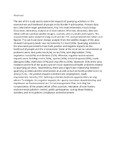Impacts of quarrying activities on the environment and livelihood of people in Border II sub-location, Nyando sub-county, Kisumu County, Kenya

View/
Date
2022-04Author
Opondo, Erick Oluoch
Ajayi, Dickson Dare
Makindi, Stanley Maingi
Metadata
Show full item recordAbstract
The aim of the study was to assess the impacts of quarrying activities on the environment and livelihood of people in the Border II sub-location. Primary data was collected through questionnaires, Key Informant Interviews, Focus Group Discussion, laboratory analysis and observations. Whereas, secondary data was obtained from Landsat satellite images, journals, articles, books and reports. The acquired data were analyzed using excel and Arc GIS; and presented into tables and figures. The Land use/cover change analysis from the satellite images of the area showed that quarry lands have increased by 5.2 Ha (0.26%). Quarrying activities in the area were perceived to have both positive and negative impacts on the livelihood of people and the environment. Some of the most serious environmental problems were; dust pollution (82%), noise (76%), land degradation (74%), vegetation loss (60%) and vibration (52%). Whereas, negative socioeconomic impacts were; building cracks (54%), injuries (36%), school dropouts (35%), roads damages (33%), child labor (31%) and crop effects (30%). Moreover, 45% of the area residents and 44% of the quarry workers have experienced health problems related to quarrying activities. Nevertheless, there was a significant relationship between quarrying activities and the environmental as well as human health problems in the area (p<0.05). The positive impacts identified are; employment, roads improvement, security, CSR, building materials, business opportunities, among others. To mitigate the negative impacts, the quarry operators should develop and implement an Environmental and Social management Plan, including fair compensation of the project which affect a person, relocation of near homes, environmental pollution control, public participation, scaling down blasting activities, and strict policies compliance and enforcement.
